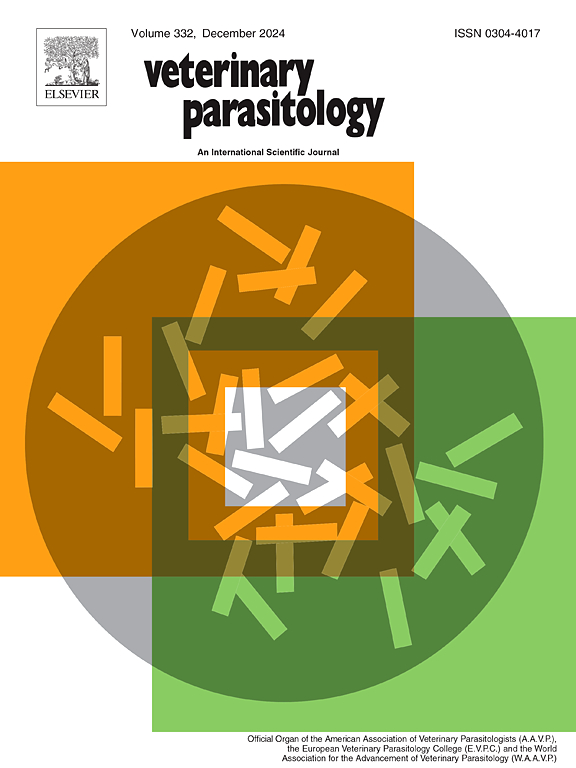Nematophagous fungi to controlling gastrointestinal nematodes in small ruminants: A systematic review
IF 2
2区 农林科学
Q2 PARASITOLOGY
引用次数: 0
Abstract
Gastrointestinal nematode infections are responsible for production losses in small ruminant worldwide. Moreover, anthelmintic resistance has increased mortality. New sustainable control strategies have been developed to overcome this problem. Biological control has emerged as a new trend with the recent market introduction of bioproducts. This systematic review aimed to analyze publications on the production of formulations and bioproducts based on helminthophagous fungi used to control gastrointestinal nematodes in sheep and goats, and to survey patents filed with this recommendation. The guidelines PRISMA 2020 were used, searching from 2004 to 2024. The following scientific databases were used: Springer, Science Direct, SciELO, Web of Science, Google Scholar, CAPES Journals and PubMed. The search for patents was carried out using the PATENTSCOPE database. Duplicate articles; review/opinion articles; studies in other animal species; studies without approval by an ethics committee; and tests performed only under in vitro conditions were excluded. Nine studies were included, six of which tested formulations and three tested bioproducts. Duddingtonia flagrans was most frequently included (8), being found in the two available bioproducts. Brazil shows the largest number of studies in the area (5). Sheep were more frequent (7) than those with goats (2). Reduction percentages ranged from 6 % to 96.6 %. Regarding patent searches, only three were found, two of which were for D. flagrans formulations and one for a utility model with Arthrobotrys drechslen. D. flagrans is the nematophagous fungus with the greatest potential to produce bioproducts in the biological control of gastrointestinal nematodes in small ruminants.
噬线虫真菌控制小反刍动物胃肠道线虫的系统综述
胃肠道线虫感染是全世界小反刍动物生产损失的主要原因。此外,驱虫抗药性增加了死亡率。为了克服这一问题,已经制定了新的可持续控制战略。生物防治已成为一种新的趋势,最近市场上推出的生物制品。本系统综述旨在分析有关以噬蠕虫真菌为基础的用于控制绵羊和山羊胃肠道线虫的制剂和生物制品生产的出版物,并调查根据本建议提交的专利。使用指南PRISMA 2020,检索从2004年到2024年。使用的科学数据库有:施普林格、Science Direct、SciELO、Web of Science、谷歌Scholar、CAPES Journals和PubMed。使用PATENTSCOPE数据库进行专利检索。重复的文章;审查/观点文章;对其他动物物种的研究;未经伦理委员会批准的研究;仅在体外条件下进行的测试被排除在外。包括9项研究,其中6项测试配方,3项测试生物制品。最常见的是在两种可用的生物制品中发现的达丁顿菌(8)。巴西在该地区进行了最多的研究(5)。绵羊比山羊更频繁(7)。减少百分比从6% %到96.6% %不等。关于专利检索,只发现了三项,其中两项是关于D. flagrans配方的,一项是关于具有关节术的实用新型的。flagrans是小反刍动物胃肠道线虫生物防治中最有潜力生产生物制品的食线虫真菌。
本文章由计算机程序翻译,如有差异,请以英文原文为准。
求助全文
约1分钟内获得全文
求助全文
来源期刊

Veterinary parasitology
农林科学-寄生虫学
CiteScore
5.30
自引率
7.70%
发文量
126
审稿时长
36 days
期刊介绍:
The journal Veterinary Parasitology has an open access mirror journal,Veterinary Parasitology: X, sharing the same aims and scope, editorial team, submission system and rigorous peer review.
This journal is concerned with those aspects of helminthology, protozoology and entomology which are of interest to animal health investigators, veterinary practitioners and others with a special interest in parasitology. Papers of the highest quality dealing with all aspects of disease prevention, pathology, treatment, epidemiology, and control of parasites in all domesticated animals, fall within the scope of the journal. Papers of geographically limited (local) interest which are not of interest to an international audience will not be accepted. Authors who submit papers based on local data will need to indicate why their paper is relevant to a broader readership.
Parasitological studies on laboratory animals fall within the scope of the journal only if they provide a reasonably close model of a disease of domestic animals. Additionally the journal will consider papers relating to wildlife species where they may act as disease reservoirs to domestic animals, or as a zoonotic reservoir. Case studies considered to be unique or of specific interest to the journal, will also be considered on occasions at the Editors'' discretion. Papers dealing exclusively with the taxonomy of parasites do not fall within the scope of the journal.
 求助内容:
求助内容: 应助结果提醒方式:
应助结果提醒方式:


